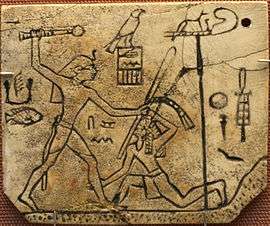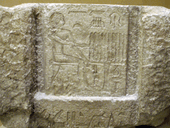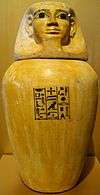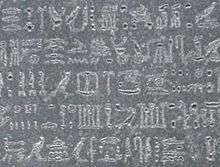N-water ripple (n hieroglyph)
| Look up 𓈖 in Wiktionary, the free dictionary. |
| ||
| "water" in hieroglyphs |
|---|
| ||
| "three ripples" in hieroglyphs |
|---|
The Egyptian hieroglyph representing "water" (Gardiner N35, Unicode 𓈖 U+13216) is attested from the earliest phase of Egyptian writing. It is notably used in the serekh name of First Dynasty pharaoh Den (Dewen) (written Ḥr-dn 𓅃𓂧𓈖 and interpreted as "he who brings the water").
The hieroglyph is zig-zagging line representing a ripple of water. Based on the acrophonic principle, based on the Egyptian word nt "water", it came to be used as the phonetic sign for /n/. One 'abbreviated' later form was a straight line with angles on each end.
The "water" hieroglyph is the historical origin of the letter M.
Use as phonograpm

The n-hieroglyph when used as a phonogram represented a preposition translationg to "in, to", or "by", etc.

Due to its use as a simple phonogram, the hieroglyph is used very frequently. For example, in the Rosetta Stone it occurs 203 times, averaging 6 times per line, for the 36 lines-(Nubayrah Stele, lines 1-22, Rosetta Stone, 1-14, therefore 36). In the stone as the water ripple, besides the preposition, it is used in names of Arsinoe, and one cartouche form of Ptolemy V Epiphanes, (the Rosetta Stone author). The vertical "N" of the Red Crown is used 35 times in the Nubayrah-Rosetta Stone, mostly prepositional; (only 4 times is it used as a non-preposition). (There are also other variants of the vertical N-Red Crown, with separate Gardiner nos. used in the Rosetta Stone, (as part of Pschent, or a variation on Egypt: "Taui", North and South Egypt, the Two Lands).)
Deshret, the vertical form of "N", is required as hieroglyphic blocks sometimes end in places not always conducive to ending a block. Two half blocks can be separated, above and below by the horizontal water ripple, or start a block, (on top), or introduce the next block, (by being on the bottom of the block). If room is not sufficient on the bottom, then a vertical form can follow to introduce the next block, thus the use of the vertical N, the red crown of the Pharaoh of the North, the Nile Delta.
 Use of letter "n" in S-n-b, the word for "health", Sen-b, or Seneb. (ripple used 4 times in text)
Use of letter "n" in S-n-b, the word for "health", Sen-b, or Seneb. (ripple used 4 times in text)- Water ripple used as 'waters' , being used with a Libation vessel
 Water ripple: preposition usage in 2nd line-(bottom of block), (also used twice in line 5)
Water ripple: preposition usage in 2nd line-(bottom of block), (also used twice in line 5)
See also
| Wikimedia Commons has media related to Ripple-of-water (n hieroglyph). |
| Wikimedia Commons has media related to Waters (hieroglyph). |
References
- Budge. An Egyptian Hieroglyphic Dictionary, E.A.Wallace Budge, (Dover Publications), c 1978, (c 1920), Dover edition, 1978. (In two volumes) (softcover, ISBN 0-486-23615-3)
- Budge. The Rosetta Stone, E.A.Wallace Budge, (Dover Publications), c 1929, Dover edition (unabridged), 1989. (softcover, ISBN 0-486-26163-8)